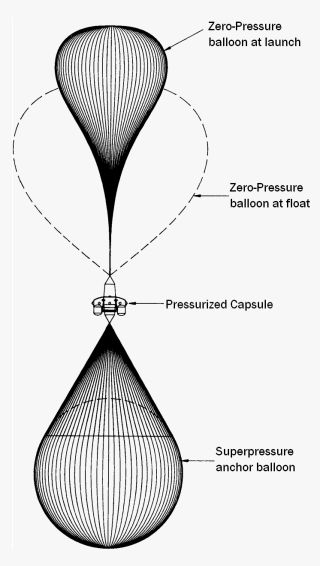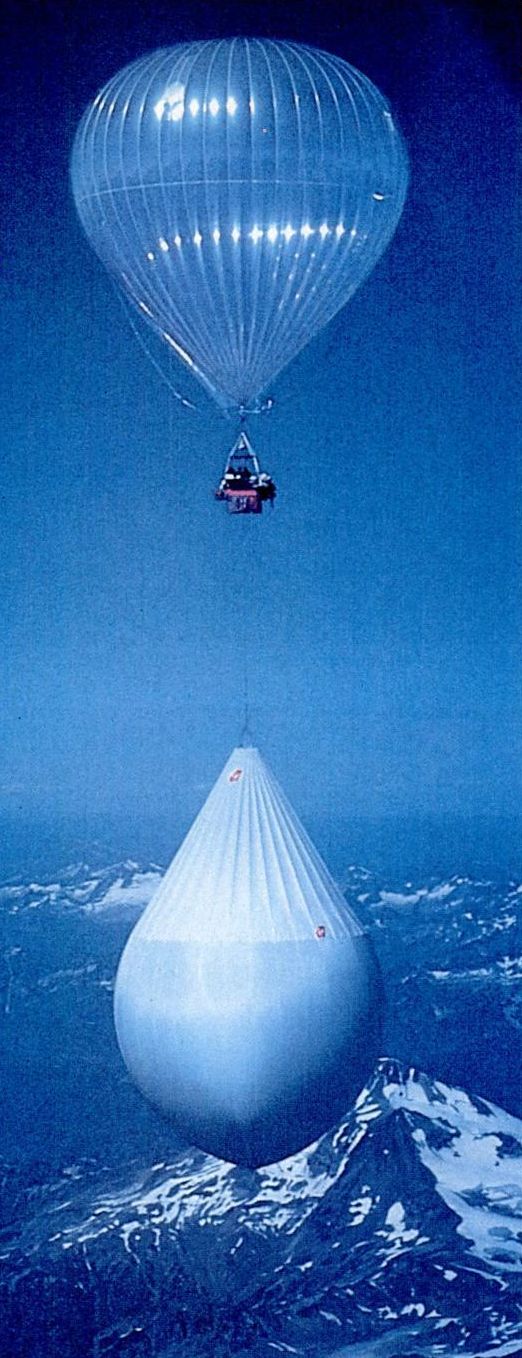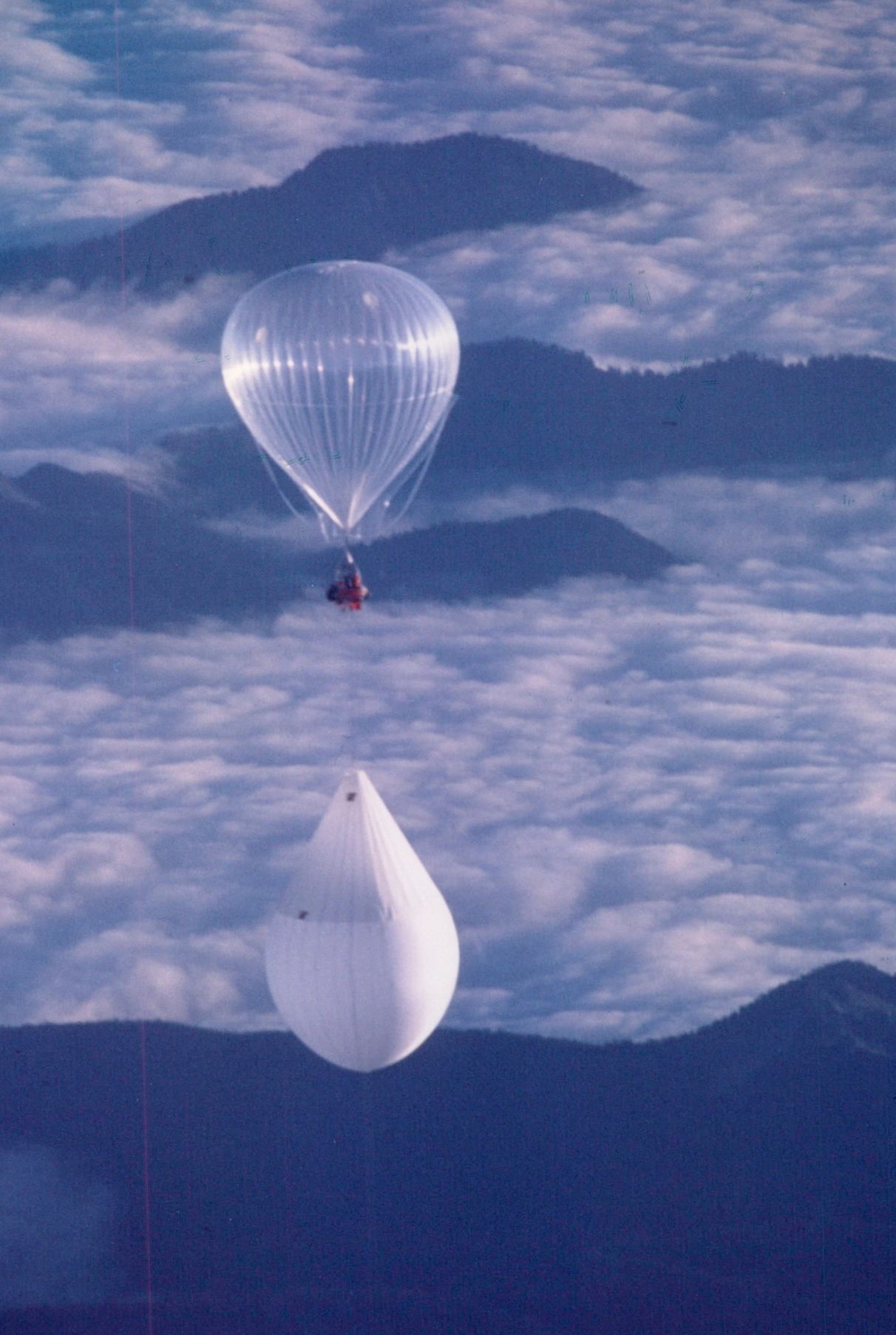Purpose of the flight and payload description
The EARTHWINDS project were a series of manned balloon missions performed along the 90's decade trying to achieve a world circumnavigation using the jet stream winds. The project was created by aeronaut Larry Newman whom was accompanied by different crews on each mission. The balloon system used in the project was based in the Sky Anchor concept originally developed at Texas A&M University in middle 70's for the balloon program of the NASA which was researching a long duration flight system. It used a helium filled zero-pressure balloon for lift and an air filled superpressure balloon for ballast.
DESCRIPTION OF THE SYSTEM
The zero-pressure main balloon with a volume of 1.2 million cubic feet was constructed with three layers of 2.0 mil Astrofilm E2. The balloon accessories included a large helium valve, ribbed wedge and collar base fitting, internal inflation tube and interface for the replenishment system. The balloon was attached to the capsule through a single point termination fitting. The superpressure anchor balloon with a volume of 0.5 million cubic feet was fabricated with a Spectra 904 outer shell and a three layer 0.8 mil Astrofilm E2 internal bladder. The anchor was suspended by a load skirt attached with a single point termination to a harness below the capsule. Both a venting valve and pressurization blower were attached via the top fitting to control the mass of air within the anchor.
The capsule for the crew was suspended from the zero-pressure balloon with the anchor balloon hanging below. A cryogenic helium replenishment system was used to increase altitude control and extend duration. It consisted of two dewars with a capacity of 750 pounds of liquid helium each. Each dewar operated independently, but shared a common ambient air heat exchanger. When evaporated, the helium from both dewars provided lift equivalent to over 10,000 pounds of ballast. The dewars and their ambient air heat exchangers were attached to the outside of the capsule.
OPERATION
With a sky anchor system, the zero-pressure balloon is filled with sufficient helium to lift itself, the payload, and a slightly pressurized anchor. When the air filled anchor balloon is at ambient pressure the enclosed air neither adds nor subtracts from the system mass. As the pressure in the anchor increases the difference in density between the enclosed and ambient air becomes effective ballast.
An equilibrium altitude is reached when the superpressure in the anchor is sufficient to balance the lift of the zero-pressure balloon. This altitude tends to be higher during the day when the helium in the zero-pressure is superheated and provides additional lift. For stable flight some superpressure must remain in the anchor at night. A characteristic of sky anchors is that the amount of superpressure required to provide stable flight is essentially independent of altitude. Changing the mass of air in the anchor, rather than changing the pressure, results only in a different equilibrium altitude. Venting air from the anchor will cause the system to climb, while pumping more air into the anchor will result in a descent. To reduce the superpressure helium must be vented from the zero-pressure balloon to reduce the amount of free-lift. Likewise, increasing the free-lift will result in a proportional increase in superpressure. Free-lift can be increased by dropping conventional ballast or in the case of Earthwinds by adding helium from the cryogenic storage. The system will then rise or descends to a new equilibrium altitude where the superpressure in the anchor again balances the free-lift.The system consisted of two balloons, an upper lifting balloon about 200 feet high filled with 1.1 million cubic feet of helium, and a 100-foot-diameter anchor balloon filled with compressed air suspended beneath the pressurized crew capsule. By pumping additional air into the anchor balloon the crew made it heavier, preventing the balloon from rising high enough to necessitate the release of helium. By releasing air from the anchor the balloon was lightened. This feature allowed the balloon to avoid the need of using conventional sand ballast, which would be exhausted after a few days.
Details of the balloon flight
Balloon launched on: 9/8/1990
Launch site: Naval Air Station Tillamook, Oregon, US
Balloon manufacturer/size/composition: Zero Pressure Balloon Anchor balloon system - Main 60 foot polyethilene 125.000 cuft / Anchor balloon 50 foot Spectra film lined with a plastic bladder
End of flight (L for landing time, W for last contact, otherwise termination time): 9/10/1990
Balloon flight duration (F: time at float only, otherwise total flight time in d:days / h:hours or m:minutes - ): 31 h
Landing site: In Omak, Washington, US
This was the first test flight of the system. It was piloted by a crew of four: pilot Larry Newman, along with former cosmonaut Vladimir Dzhanibekov, engineer Tim Lachenmeier and Hawaii builder Don Moses. The balloon was launched at 20:45, on September 8th, 1990 from the blimp hangars at Tillamook, Oregon after an scrubbed attempt that same morning. The balloon system consisted of a 125.000 cubic foot zero-pressure polyethylene balloon with a 50 foot diameter Spectra anchor balloon, and an open gondola suspended between the two balloons. The venting valve on the anchor was used to control the climb rate and to stop the system at several intermediate altitudes.
Once a peak altitude of 19,500 feet was reached the blower was used to add air to the anchor and bring the system down to the final cruising altitude of 17,500 feet. To compensate for the morning sun superheat the blower was used to add more air and hold the system below 18,000 feet. During the days maximum superheat the anchor balloon superpressure reached just under 1 psi. A constant altitude was maintained through sunset by using the anchors venting valve to release air. The flight lasted 32 hours and was terminated just prior to sunrise of the second day. The only conventional ballast necessary on the flight was used to control the descent to landing after the anchor balloon had become depressurized and could no longer provide effective ballast. The landing was made with the partially deflated anchor serving as a large drag rope. In a ground wind of 5-7 knots dragging the deflated anchor proved sufficient to stop the systems forward motion.
A soft touchdown of the gondola was made as the remaining helium was vented from the zero-pressure balloon. The prototype system used a triple wall .8 mil Astrofilm E2 zero-pressure balloon, and an anchor constructed with a Spectra 904 shell and a triple wall .8 mil Astrofilm E2 internal bladder. The anchor complete with fittings, load skirt, valves and blower assembly weighed 690 pounds. At 18,000 ft and 1 psi of superpressure, the anchor balloon provided 370 pounds of effective ballast. The prototype anchor system thus weighs less than the amount of conventional ballast required to survive just two sunsets.
External references
- Design of a trans-global manned balloon system with relevance to scientific ballooning International Balloon Technology Conference - Balloon Systems Conferences - AIAA (1991)
- Meteorological Support to the Earthwinds Transglobal Balloon Project Bull. Amer. Meteor. Soc., 76, 477-487
- The selection and evaluation of materials for the Earthwinds transglobal balloon flight International Balloon Technology Conference - Balloon Systems Conferences - AIAA (1991)
10351If you consider this website interesting or useful, you can help me to keep it up and running with a small donation to cover the operational costs. Just the equivalent of the price of a cup of coffee helps a lot.




